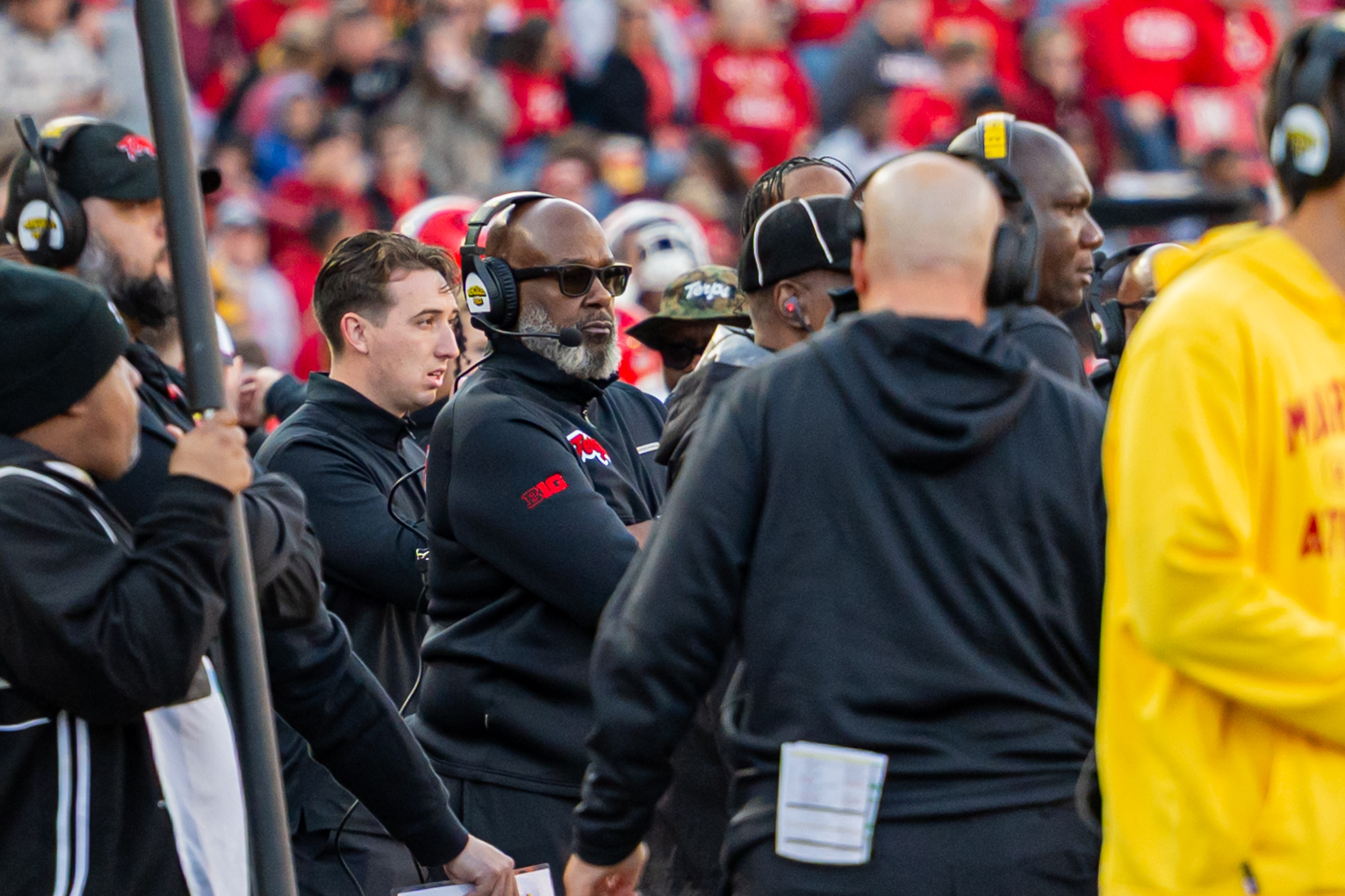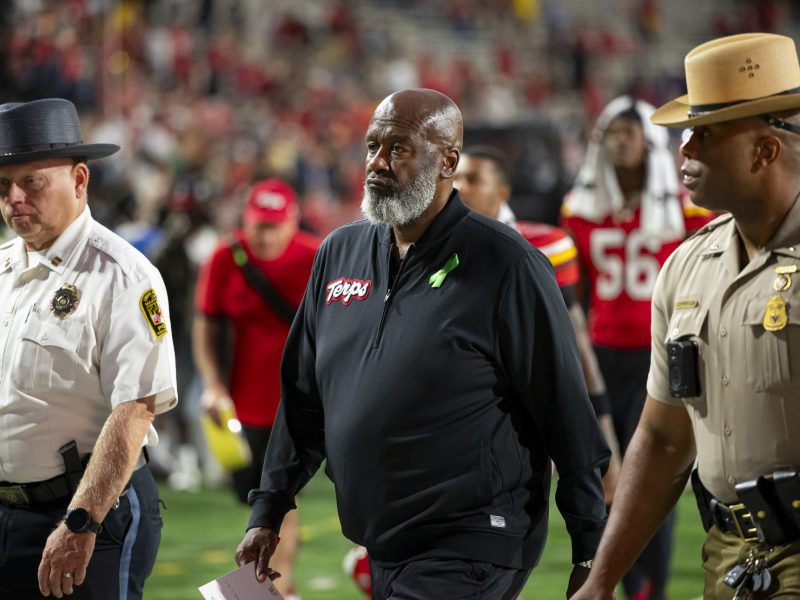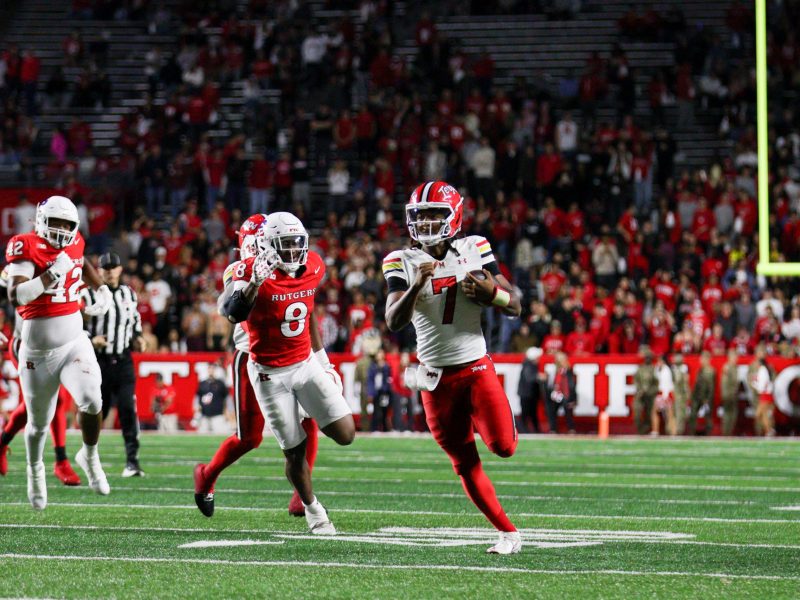Maryland football coach Michael Locksley’s expectations may have been unrealistic.
The seventh-year coach said during the week he felt “pretty good” about the Terps’ chances against No. 2 Indiana on Saturday. Locksley cited Maryland’s prior three games, each one-score losses caused by self-inflicted mistakes. He thought they were correctable.
The Terps instead put together their worst performance of the season. Maryland averaged 2.2 yards a rush, allowed nearly 600 yards and held the ball for less than half the time of Indiana.
“I obviously didn’t coach well enough, the players obviously didn’t execute well enough,” Locksley said. “One of the things that I’ll continue to say is that we’re not going to be victims — we’ll get this thing corrected.”
Here are three takeaways from the Terps’ 55-10 loss.
Turnovers cost Maryland
Maryland entered Saturday with five turnovers committed and an FBS-leading plus-1.57 turnover differential per game.
Cornerback Jamare Glasker recorded the Terps’ Big Ten-leading 15th interception on the Hoosier’s opening possession. Indiana played turnover-free afterward, while Maryland ended with five.
Malik Washington threw interceptions on consecutive second-quarter possessions, each leading to Indiana scores. The first came when the freshman quarterback tossed a pass directly at a linebacker, the next on a deep shot.
[Fans growing restless as Maryland football drops fourth straight, 55-10 to No. 2 Indiana]
“We talk a lot about being able to protect the ball,” Washington said. “Today we tried to force the issue a little bit, I’ll take that on myself.”
Locksley shouldered blame for Washington’s struggles, which included a fumble in the third quarter returned for a touchdown. Senior receiver Octavian Smith Jr. lost a fumble on the Terps’ next possession and Maryland turned it over on downs on the ensuing drive. Locksley said the “wheels kind of fell off” during that stretch.
While Indiana’s second-ranked Big Ten scoring defense didn’t sack Washington, it consistently forced him to make off-balance throws into tight windows. He was also stuck in third-and-long situations for much of the contest, converting just three of 12 third downs.
Lopsided rushing numbers
Indiana finished with 330 more rushing yards than Maryland.
No Terps running back recorded a rush of more than four yards. Freshman Iverson Howard led on the ground with 12 yards. Running back DeJuan Williams paced the team in receiving for a second straight game, but notched only 10 rushing yards. Washington carried only three times after saying he wanted to use his legs more.
Locksley said Maryland needs to alleviate pressure on Washington better when he’s struggling — something a strong run game can do.
But it’s been absent all year. The Terps rank last in the Big Ten in rushing yards, rushing yards a game and rushing attempts, while Washington sits second in the conference in passing attempts.
“If you got a really talented freshman quarterback, the worst thing you can do is have him get beat up,” Locksley said during the week.
Maryland’s defense continued its own downward spiral in the ground game.
Following consecutive games allowing almost 200 rushing yards, the Terps conceded 367 yards and four rushing touchdowns to the Hoosiers. Including three nonconference games, Maryland is surrendering 186.4 rushing yards a game at SECU Stadium.
[Watching film with Maryland football’s Cam Rice: pass rush, preparation and technique]
“That’s a lot of rushing yards,” graduate student Cam Rice said of the team’s run defense Saturday. “Especially as a defensive lineman, you never want to allow a team to rush like that on you.”
Locksley’s Big Ten woes continue
The loss moved Locksley to 16-39 in conference play in his current Maryland tenure.
It’s tough to fault Locksley for winning only three Big Ten games across his first two seasons since he took over a program in turmoil after DJ Durkin’s abrupt firing. And despite his inability to beat the conference’s elites, Locksley led the Terps to three consecutive bowl game wins from 2021 to 2023.
But 2024 and the first five Big Ten games of this season have been a major step back.
Maryland is 2-12 in conference play since the start of last season — only Purdue, which hasn’t won a Big Ten game since 2023, boasts fewer wins in the span. The Terps lost their last five games of 2024, losing by an average of 22.6 points.
Locksley expressed belief this campaign will be different. He pointed to a strong relationship with the players, in contrast to last season, where he admitted to losing the locker room.
“Not the same old Maryland,” Locksley said.
Maryland will likely need to record two more wins to earn a bowl game berth and at least somewhat prove its coach right.
If the Terps can’t, doubts may heighten about the leadership surrounding this young, talented team — beginning with Locksley.



